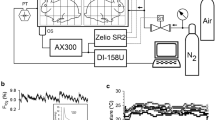Abstract
The early ventilatory response to transient hypoxia was examined in the anaesthetized rabbit. In intact spontaneously breathing animals, an increase in tidal volume (V T) with an accompanying slight increase in inspiratory duration (T I) and a decrease in the expiratory duration (T E) was observed. After vagotomy, the ventilatory response was distinguished by a greater increase inV T and a significant decrease inT I andT E.
In another group of artificially ventilated rabbits, an increase in inspiratory volume with a simultaneous decrease in breathing frequency was found to involve a smaller reflex increase in phrenic inspiratory discharge after onset of transient hypoxia.
These observations suggest that afferents from pulmonary vagal stretch receptors inhibit those from arterial chemoreceptors.
Similar content being viewed by others
References
Amdur, M. O., Mead, J.: Mechanics of respiration in unanesthetized guinea pigs. Amer. J. Physiol.192, 364–368 (1958)
Bartlett, D., Sant'Ambrogio, G., Wise, J. C. M.: Transduction properties of tracheal stretch receptors. J. Physiol. (Lond.)258, 421–432 (1976)
Biscoe, T. J., Purves, M. J., Sampson, S. R.: The frequency of nerve impulses in single carotid body chemoreceptor afferent fibres recorded in vivo with intact circulation. J. Physiol. (Lond.)208, 121–131 (1970)
Bouverot, P., Fitzgerald, R. S.: Role of the arterial chemoreceptors in controlling lung volume in the dog. Respir. Physiol.7, 203–215 (1969)
Bouverot, P., Crance, J. P., Dejours, P.: Factors influencing the intensity of the Breuer-Hering inspiration-inhibiting reflex. Respir. Physiol.8, 376–384 (1970)
Boychuk, R. B., Rigatto, H., Seshia, M. M. K.: The effect of lung inflation on the control of respiratory frequency in the neonate. J. Physiol. (Lond.)270, 653–660 (1977)
Bradley, G. W., Von Euler, C., Marttila, I., Roos, B.: Transient and steady-state effects of CO2 on mechanisms determining rate and depth of breathing. Acta Physiol. Scand.92, 341–350 (1974)
Clark, F. J., Von Euler, C.: On the regulation of depth and rate of breathing. J. Physiol. (Lond.)222, 267–295 (1972)
Dejours, P.: Chemoreflexes in breathing. Physiol. Rev.42, 335–358 (1962)
Delpierre, S., Guillot, C., Jammes, Y., Grimaud, C.: Interaction between vagal and chemoreceptors afferents in ventilatory response to transient hypercapnia (anaesthetized rabbit). Arch. Internat. Physiol. Bioch.85, 27–38 (1977)
Gardner, W. N.: The relation between tidal volume and inspiratory and expiratory times during steady-state carbon dioxide in man. J. Physiol. (Lond.)272, 591–611 (1977)
Gautier, H.: Respiratory activity and peripheral chemosensitivity in the cat. In: Respiratory centres and afferent systems (B. Duron, ed.), pp. 221–224. Paris: INSERM 1976
Gautier, H., Remmers, J. E., Bartlett, D.: Control of the duration of expiration. Respir. Physiol.18, 205–221 (1973)
Gesell, R., White, F.: Recruitment of muscular activity and the central neurone after-discharge of hyperpnea. Amer. J. Physiol.122, 48–56 (1938)
Gill, P. K.: The effects of end-tidal CO2 on the discharge of individual phrenic motoneurones. J. Physiol. (Lond.)168, 239–257 (1963)
Kleinman, L. I., Radford, J. R.: Ventilation standards for small mammals. J. Appl. Physiol.19, 360–362 (1964)
Koepchen, H. P., Langhorst, P., Seller, H., Polster, J., Wagner, P. H.: Neuronale Aktivität im unteren Hirnstamm mit Beziehung zum Kreislauf. Pflügers Arch.264, 40–64 (1967)
Koike, H., Mark, A. L., Heistad, D. D., Schmid, P. G.: Influence of cardiopulmonary vagal afferent activity on carotid chemoreceptor and baroreceptor reflexes in the dog. Circ. Res.37, 422–429 (1975)
Lahiri, S., Delaney, R. G.: Stimulus interaction in the responses of carotid body chemoreceptor single afferent fibres. Respir. Physiol.24, 249–266 (1975)
Miller, M. J., Tenney, S. M.: Hyperoxic hyperventilation in carotiddeafferented cats. Respir. Physiol.23, 23–30 (1975)
Phillipson, E. A., Hickey, R. F., Graf, P. D., Nadel, J. A.: Hering-Breuer inflation reflex and regulation of breathing in conscious dogs. J. Appl. Physiol.31, 746–750 (1971)
Widdicombe, J. G.: Respiratory reflexes in man and other mammalian species. Clin. Sci.21, 163–170 (1961)
Author information
Authors and Affiliations
Rights and permissions
About this article
Cite this article
Delpierre, S., Guillot, C., Fornaris, M. et al. Transient hypoxia: Ventilatory response after vagotomy and during artificial phasic inflation. Pflugers Arch. 379, 53–57 (1979). https://doi.org/10.1007/BF00622905
Received:
Issue Date:
DOI: https://doi.org/10.1007/BF00622905




